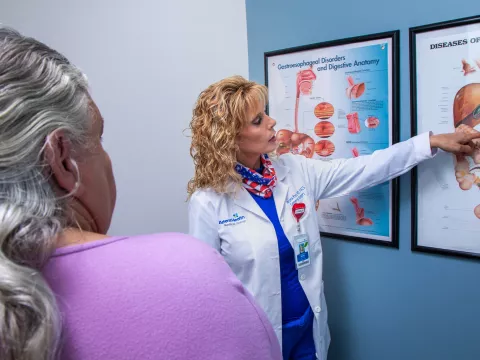- AdventHealth
Gallstones and kidney stones can both cause pain and require immediate medical attention, but they form in different systems of the body by blocking the flow of fluids. This is why it’s important to seek treatment quickly if you experience pain and other symptoms of gallstones or kidney stones.
But you may have had apprehension about getting the care you need right now. We want you to have peace of mind knowing we’re focused on protecting your whole health. This includes protecting you from COVID-19. Our enhanced safety measures are designed to keep you safe while in our care, so you can feel confident about getting the important health care you need.
Understand the Difference Between Kidneys and Gallbladders
Your kidneys are part of your urinary system. They filter blood, which then creates urine. A kidney stone is a solid mass made up of tiny crystals from minerals like calcium, oxalate and uric acid that can form in your kidneys.
Your gallbladder, on the other hand, is part of your digestive system. It stores bile produced by the liver, which aids in the digestion and absorption of fats. Gallstones are hard, pebble-like deposits of cholesterol or pigment that form inside the gallbladder. They can be as small as a grain of sand or as large as a golf ball.
Similarly, there can be one or more stones in the kidney or gallbladder at the same time.
Know Your Risk
Hispanic or Native American women over the age of 40 with the following conditions are most likely to have gallstones:
- Diabetes
- Obesity
- Rapid weight loss
Kidney stones are more prevalent in men over 40 than in women. And once you’ve had one, there’s a 50 percent chance you’ll develop another over the next 10 years. Having a history of gallstones or kidney stones increases your risk of having both in the future.
Recognize the Symptoms
Most people with gallstones experience no symptoms, but when the gallstone begins to block the biliary tract, you may experience:
- Back pain
- Nausea
- Pain in your upper right abdomen
- Vomiting
Like gallstones, some kidney stones will also go unnoticed. But if they’re large, they can stretch and irritate the ureter, blocking urine and causing severe pain that’s often described as a sharp cramping in the back and side near the kidney. The intense pain of a kidney stone may also be accompanied by:
- Blood in your urine
- Nausea
- Vomiting
Treatments for Kidney stones and Gallstones
Sometimes, gallstones don’t cause any pain or symptoms. But if they do, a surgery called laparoscopic cholecystectomy is usually recommended. Fortunately, the gallbladder is an organ you can live without. It is possible to eliminate the stones while preserving the gallbladder, but it’s often not recommended since the risk of producing more stones is high.
When it comes to kidney stones, smalls ones can (and usually will) pass on their own. Your doctor will most likely advise you to stay home, drink liquids and take pain medication as needed until the stone passes.
However, if the pain is too severe or a stone is blocking your urinary tract, a non-surgical medical procedure called lithotripsy may help. During this procedure, high energy shock waves are used to break the stone into pieces as small as grains of sand, which can then pass through your urine.
Preventing Gallstones and Kidney Stones
Diet plays a major role in the prevention of gallstones and kidney stones. Maintaining a healthy, balanced lifestyle is the best prevention. Being overweight is a risk factor, so achieving and maintaining a healthy weight can reduce your risk.
To prevent kidney stones, it’s important to drink plenty of fluids (mostly water). For gallstone prevention, avoid quick, sudden weight loss or severe calorie restriction. Healthy fiber intake can also help reduce your risk.
Feel Confident Getting the Care You Need
If you're experiencing symptoms of gallstones or kidney stones, it's important to get medical attention right away. If you visit an AdventHealth facility or provider for care, you’ll see we’re taking these precautions to keep your care safe:
- Treating all symptomatic and COVID-positive patients in separate areas of the facility
- Social distancing in waiting areas
- Temperature checks upon entering our facilities
- Universal mask use for staff, patients and visitors
- Visitor limits at some locations
For your safety (and the safety of our healthcare team), we’ll continue with these measures for as long as necessary. We’re working hard to help you stay healthy and get back to the life you love. Learn more about our Digestive Care experts.



